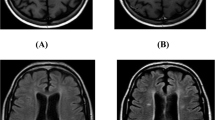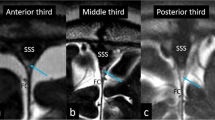Abstract
We evaluated the “dural tail” associated with 48 intracranial meningiomas on fluid-attenuated inversion-recovery (FLAIR) and contrast-enhanced T1-weighted images. In 30 (62.5%), a dural tail was observed on contrast-enhanced T1-weighted images, and thickening of the dura mater and abnormal signal were identified in the corresponding region on FLAIR images. Thus, FLAIR imaging was useful for showing dural abnormality associated with meningiomas without the needed for contrast medium.




Similar content being viewed by others
Reference
Gupta S, Gupta RK, Banerjee D, Gujral RB (1993) Problems with the “dural tail” sign. Neuroradiology 35: 541–542
Kutcher TJ, Brown DC, Maurer PK, Ghaed VN (1991) Dural tail adjacent to acoustic neuroma: MR features. J Comput Assist Tomogr 15: 669–670
Tien RD, Yang PJ, Chu PK (1991) “Dural tail sign”: a specific MR sign for meningioma? J Comput Assist Tomogr 15: 64–66
Senegor M (1991) Prominent meningeal “tail sign” in a patient with a metastatic tumor. Neurosurgery 29: 294–296
Schorner W, Schubeus P, Henkes H, Lanksch W, Felix R (1990) “Meningeal sign”: a characteristic finding of meningiomas on contrast-enhanced MR images. Neuroradiology 32: 90–93
Aoki S, Sasaki Y, Machida T, Tanioka H (1990) Contrast-enhanced MR images in patients with meningioma: importance of enhancement of the dura adjacent to the tumor. AJNR 11: 935–938
Goldsher D, Litt AW, Pinto RS, Bannon KR, Kricheff, II (1990) Dural “tail” associated with meningiomas on Gd-DTPA-enhanced MR images: characteristics, differential diagnostic value, and possible implications for treatment. Radiology 176: 447–450
Nagele T, Petersen D, Klose U, Grodd W, Opitz H, Voigt K (1994) The “dural tail” adjacent to meningiomas studied by dynamic contrast-enhanced MRI: a comparison with histopathology. Neuroradiology 36: 303-307
Tokumaru A, O’Uchi T, Eguchi T, et al (1990) Prominent meningeal enhancement adjacent to meningioma on Gd-DTPA-enhanced MR images: histopathologic correlation. Radiology 175: 431–433
Hajnal JV, De Coene B, Lewis PD, et al (1990) High signal regions in normal white matter shown by heavily T2-weighted CSF nulled IR sequences. J Comput Assist Tomogr 16: 506–513
De Coene B, Hajnal JV, Gatehouse P, et al (1992) MR of the brain using fluid-attenuated inversion recovery (FLAIR) pulse sequences. AJNR 13: 1555–1564
Kuroiwa T, Ohta T (2000) MRI appearances mimicking the dural tail sign: a report of two cases. Neuroradiology 42:199–202
Morioka T, Matsushima T, Ikezaki K, et al (1993) Intracranial adenoid cystic carcinoma mimicking meningioma: report of two cases. Neuroradiology 35: 462–465
Good CD, Kingsley DP, Taylor WJ, Harkness WF (1997) “Dural tail” adjacent to a giant posterior cerebral artery aneurysm: case report and review of the literature. Neuroradiology 39: 577–580
Rydberg JN, Hammond CA, Grimm RC, et al (1994) Initial clinical experience in MR imaging of the brain with a fast fluid-attenuated inversion-recovery pulse sequence. Radiology 193: 173–180
Noguchi K, Ogawa T, Inugami A, Toyoshima H, Okudera T, Uemura K (1994) MR of acute subarachnoid hemorrhage: a preliminary report of fluid-attenuated inversion-recovery pulse sequences. AJNR 15: 1940–1943
Essig M, Hawighorst H, Schoenberg SO, et al (1998) Fast fluid-attenuated inversion-recovery (FLAIR) MRI in the assessment of intraaxial brain tumors. J Magn Reson Imaging 8: 789–798
Shimizu T, Miki H, Takeguchi T, Kikuchi K, Mochizuki T, Ikezoe J (2003) Usefulness of turbo-fluid-attenuated inversion-recovery (tFLAIR) sequence in diagnosing meningioma. Radiat Med 21: 55–61
Wilms G, Lammens M, Marchal G, et al (1989) Thickening of dura surrounding meningiomas: MR features. J Comput Assist Tomogr 13: 763–768
Author information
Authors and Affiliations
Corresponding author
Rights and permissions
About this article
Cite this article
Takeguchi, T., Miki, H., Shimizu, T. et al. The dural tail of intracranial meningiomas on fluid-attenuated inversion-recovery images. Neuroradiology 46, 130–135 (2004). https://doi.org/10.1007/s00234-003-1152-4
Received:
Accepted:
Published:
Issue Date:
DOI: https://doi.org/10.1007/s00234-003-1152-4




